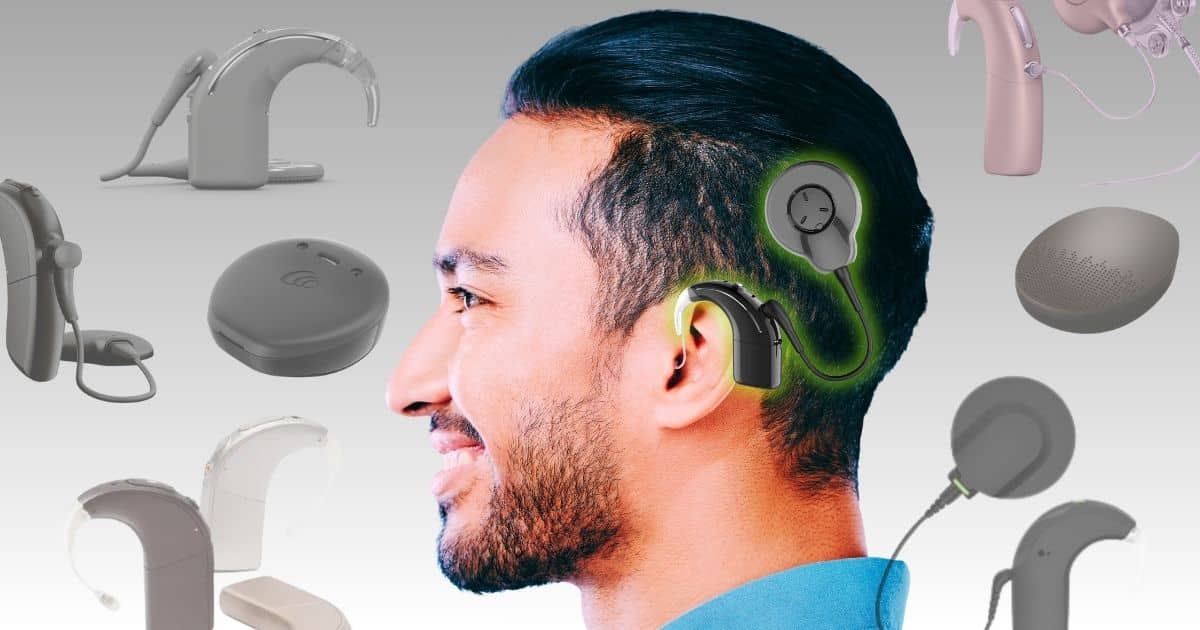For many, life’s most cherished moments are intertwined with the sensory memories they create. The laughter of loved ones, the beauty of music, or the whisper of the wind through the trees. However, imagine a world where these treasured sensations are forever out of reach.
For those who grapple with profound hearing loss, the symphony of life remains muted, its vibrancy reduced to silence. Fortunately, the medical science and technology has ushered in a new era of hope for millions worldwide. The advent and evolution of hearing amplification devices, including various types of hearing aids and, more notably, cochlear implants, have bridged the vast divide between the world of silence and sound.
In this article we will dive into understanding cochlear implants and its associated processes.
- Flow of Sound: How we hear
- Cochlear Implants
- How Cochlear Implants Work
- Hearing Aids vs. Cochlear Implants: What’s the difference?
- Candidacy for Cochlear Implants: Children vs. Adults
- The Implantation Process
- Cochlear Implant Brands, Models, Features
- Fully Under Skin Cochlear Implant?
- Advancements and Future Developments
The Flow of Sound
To comprehend the significance of cochlear implants, one must first understand the auditory pathway. Sound, in the form of vibrations, journeys from the outer ear through the ear canal, causing the eardrum (tympanic membrane) to vibrate.
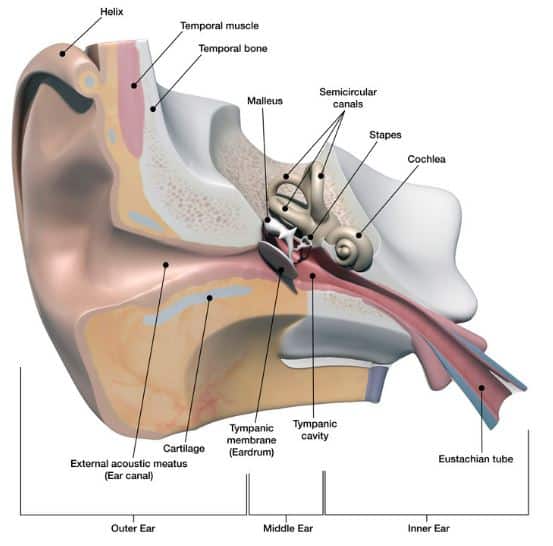 These vibrations transmit to the bones of the middle ear, which, in turn, forward the auditory signals to the cochlea, the hearing organ. Within the cochlea, minuscule hair cells respond to these sound waves, generating electrical impulses. These impulses then traverse the auditory nerve, carrying the auditory message to the brain, where it is interpreted as sound.
These vibrations transmit to the bones of the middle ear, which, in turn, forward the auditory signals to the cochlea, the hearing organ. Within the cochlea, minuscule hair cells respond to these sound waves, generating electrical impulses. These impulses then traverse the auditory nerve, carrying the auditory message to the brain, where it is interpreted as sound.
A damaged cochlea, the snail-shaped structure in the inner ear, constitutes the most prevalent cause of hearing loss. The extent of damage correlates with the severity of hearing loss, and while some cases can be managed with traditional hearing aids, profoundly damaged cochleae serve as a barrier that traditional amplification devices cannot overcome.
Cochlear Implants
The concept of the cochlear implant originated from the groundbreaking discovery that electrical currents could convey meaningful sounds to the brain. Cochlear implants serve as innovative devices designed to surmount the obstacles posed by a damaged cochlea. These implants bypass the impaired cochlea, directly stimulating the auditory nerve, and sending sound impulses to the brain.
A cochlear implant typically consists of invasive surgery, during which electrodes are implanted onto the auditory nerve within the skull, hence the name “implant.”
The device is composed of two parts:
- Internal component, nestled within the base of the skull
- External component visible on the outer ear
The two parts connect through the skin, anchored in place by a magnet. Externally, an antenna, affixed to the skull with a magnet, captures sounds for amplification.
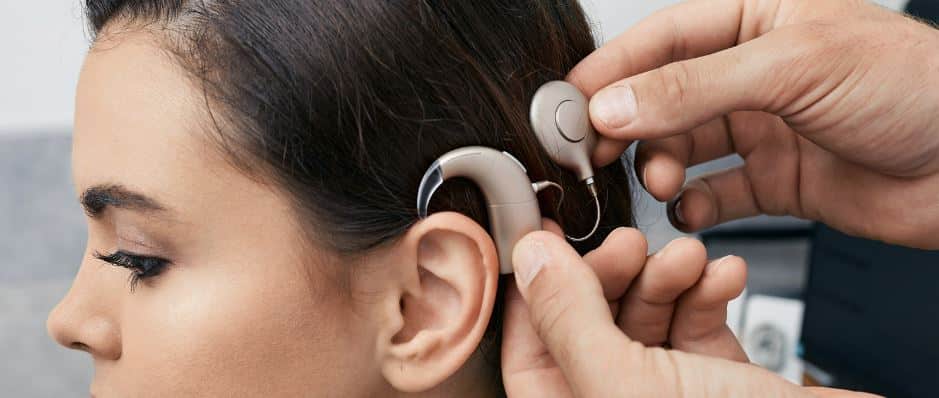
How Cochlear Implants work
Referred to as “bionic ears,” cochlear implants establish a new pathway for sound conduction to the brain. The individual wears a sound processor, akin in appearance to a traditional hearing aid, situated behind the ear.
This sound processor houses a microphone, which captures incoming sounds. These sounds are then relayed to a transmitter, resembling an antenna, attached to the scalp through a magnet.
The transmitter converts the sound signals into electrical impulses, which travel through the skin to reach the internal electrodes. These electrodes, in turn, stimulate the auditory nerve, alerting the brain to incoming sound, where it is interpreted.
Distinguishing Cochlear Implants from Traditional Hearing Aids
Cochlear implants are distinct from traditional hearing aids in several fundamental ways.
While traditional hearing aids enhance residual hearing, cochlear implants function through direct electrical stimulation of the acoustic nerves within the auditory system, creating the sensation of sound for those who are deaf or severely hard of hearing.

Traditional Behind the Ear hearing aid (left) vs cochlear implant (right)
Traditional hearing aids are non-invasive, requiring no surgical procedures and can be easily removed. In contrast, cochlear implants necessitate surgical implantation to establish a direct connection with the auditory nerve.
The only exception to this is what is referred to as a Bone Anchored Hearing Aid (BAHA) which sometimes gets mistaken for a cochlear implant.
A BAHA is a specialized hearing device designed for individuals with conductive or mixed hearing loss, where sound waves struggle to pass through the middle or outer ear (in contrast Cochlear Implants are for those with nerve-related hearing loss).
Unlike traditional hearing aids, a BAHA doesn’t amplify sound through the ear canal but instead bypasses the damaged or blocked ear by transmitting vibrations directly to the inner ear via the skull bone. A small titanium implant is surgically anchored in the bone behind the ear, which serves as a stable foundation for attaching the external processor.

Bone Anchored Hearing Aid (BAHA) shown, is often times confused for a cochlear implant. Image credit: Cochlear
Candidacy for Cochlear Implants: Children vs. Adults
Candidates for cochlear implants must meet strict criteria, as these devices may not be suitable for all forms of hearing loss.
Awareness and financial considerations can also pose barriers for many individuals. In the case of children, candidacy criteria include the following:
- Children between 9 and 18 months of age: Profound sensorineural hearing loss of 90 decibels or greater in both ears.
- Children 24 months and older: Severe-to-profound sensorineural hearing loss of 70 decibels or greater in both ears.
- Lack of benefit from optimally fitted hearing aids
- No medical contraindications (e.g., damaged auditory nerve, middle ear infections, certain developmental disorders)
- Lack of progress in developing auditory skills with a hearing aid or other amplification
- High motivation and realistic expectations from the family
Children fitted with cochlear implants at the age of three or younger tend to exhibit improved outcomes, as their young brains adapt and rewire more effectively to incoming sounds, potentially leading to enhanced speech and language development compared to those fitted later in life.
For adults, the candidacy criteria encompass:
- Eighteen years of age or older
- Moderate-to-profound, bilateral sensorineural hearing loss
- Limited benefit from appropriately fitted hearing aids
- High motivation and family support
- Realistic expectations
- No medical contraindications
To ascertain eligibility for cochlear implantation, candidates undergo a battery of audiological and medical tests, which include full audiological assessments to determine the extent of hearing loss, auditory brainstem response (ABR) tests, vestibular tests to evaluate inner ear and balance function, and imaging studies such as magnetic resonance imaging (MRI) or computed tomography (CT) scans to examine inner ear structure.
The Implantation Process
Following the evaluation and determination of candidacy, the next step involves implantation surgery, performed under general anesthesia. This procedure typically lasts between two and four hours, and patients usually spend one night in the hospital. While the internal components are in place post-surgery, the surgical site requires time to heal before the external device can be attached.
Approximately four to six weeks after surgery, the patient returns to the cochlear implant center for the fitting of the external device. During this appointment, the audiologist activates the cochlear implant and begins the process of ‘mapping’ the processor according to the individual’s specific needs. This moment marks a significant milestone, as it is often the first time many patients, both children and adults, experience sound through their implants.

Fine-tuning and adjustments follow the initial fitting, allowing the individual to acclimate to their new auditory experience. This process is particularly important for children who have never heard sound before and for those adapting to a new mode of hearing. Auditory rehabilitation programs aim to assist the brain in making sense of sound, fostering the development of auditory skills.
Cochlear Implant: Pros and Cons
Cochlear implants offer a range of benefits, including:
- Hearing Improvement: Cochlear implants enhance hearing and speech perception, allowing individuals to comprehend speech, even in the presence of background noise. These devices enable users to hear various sounds, including phone conversations and television audio.
- Future Learning and Career Opportunities: For children with cochlear implants, these devices facilitate learning in academic settings, opening doors to future career opportunities.
- Speech Development: Cochlear implants enhance speech clarity, contributing to improved listening and language skills.
- Safety: The ability to hear environmental sounds, such as sirens and alarms, enhances safety.
However, it’s crucial to acknowledge the challenges:
- Limited Restoration of Hearing: While cochlear implants offer substantial hearing improvements, they do not fully restore natural hearing. Outcomes vary among individuals.
- Surgery: Cochlear implantation involves surgery with associated risks and limitations.
- Activity Considerations: While individuals with cochlear implants can engage in most activities, precautions are necessary to protect the device from damage, especially when participating in activities like sports or swimming.
- Cost: The financial aspect can be a barrier for some, as cochlear implants may not be covered by all insurance plans.
- Maintenance: Cochlear implants require ongoing care, including battery replacement, wire adjustments, and recalibration.
- Background Noise: Challenges may persist regarding background noise in loud environments.
Cochlear Implant Brands, Models, and Features
The cochlear implant landscape is shaped by several renowned brands, including Cochlear, Advanced Bionics, and MED-EL. These companies have dedicated themselves to advancing technology in their implant systems, offering various options, such as behind-the-ear and off-the-ear processors, rechargeable batteries, water- and dust-resistant designs, and direct streaming from iOS and Android devices.
Cochlear
Cochlear is the largest hearing implant manufacturer in the world and currently offers the Nucleus 8 and Kanso 2 sound processors. The company’s latest devices facilitate direct streaming to compatible Apple, Android, and Amazon Fire TV devices, supporting Bluetooth LE Audio technology for greater sound accessibility across various devices and environments.

Additionally, Cochlear also makes accessories, such as Aqua+ silicone sleeve protectors, which waterproofs cochlear processors and has the Cochlear CoPilot app that helps recipients learn more about how to use their cochlear implants and boost communication skills with the device to maximize its effectiveness.
MED-EL
MED-EL‘s Synchrony and Synchrony 2 cochlear implant devices are known for their versatility, with options for various electrode lengths to accommodate diverse cochlear shapes. MED-EL also offers audio processors like RONDO 3 and Sonnet 2, both known for their wireless connectivity and water-resistant designs.

SYNCHRONY 2 Cochlear Implant with SONNET 2 and RONDO 3 audio processors
Advanced Bionics
Advanced Bionics stands out for its high-resolution sound coding programs and an array of cochlear implant options in different styles. Being part of the Sonova Group, the company’s implants offer compatibility with Phonak hearing aids for those who wear a hearing aid in the opposite ear.
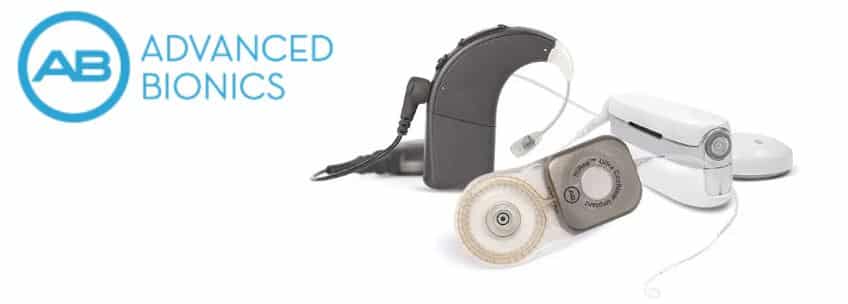
They offer processors that are compatible with direct streaming, ensuring that users can seamlessly stream audio from their preferred devices. The company’s Neptune™ is the world’s first swimmable sound processor, suitable for people of all ages and lifestyles. It offers a unique design that allows users to choose how they wear it, be it in their hair, on their arm, under their collar, or in their pocket, all while maintaining excellent hearing performance. The addition of the AquaMic™ headpiece, the sole waterproof headpiece microphone in the industry, ensures uncompromised underwater hearing for users, including children.
Oticon Medical
Oticon Medical was poised to become a significant player in the cochlear implant space, however, parent company Demant decided to divest its CI division to competitor Cochlear in 2022.
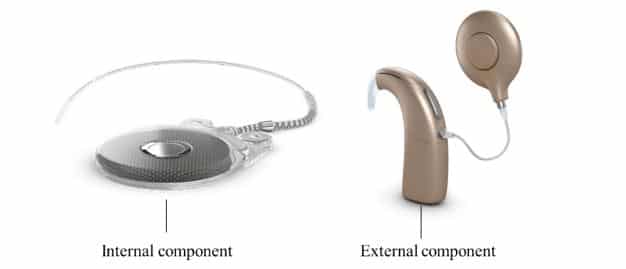
In addition, all of these companies also offer extensive customer support beyond the use of the device through linkage to support groups and other helpful resources.
Fully Implanted Cochlear Implant?
Unlike current cochlear implants that rely on external hardware, the Acclaim® from Envoy Medical is the first fully implanted cochlear implant. It utilizes an implanted middle ear sensor and an implanted rechargeable power supply, eliminating the need for any externally worn components. This design helps to alleviate common issues such as discomfort and restrictions in daily activities like sleeping, showering, and strenuous exercise.
A distinctive feature of the Acclaim® is its utilization of the patient’s natural ear, rather than an external microphone, to capture acoustic energy. During the day, it doesn’t require an external processor or daily recharging, offering greater convenience and freedom to users.
Currently undergoing an early feasibility study at the Mayo Clinic, this groundbreaking cochlear implant has already received Breakthrough Device Designation from the U.S. Food and Drug Administration (FDA), paving the way for its potential pivotal trial in the United States.
While this fully implanted cochlear implant shows great promise, it is essential to note that the technology is still in development, with careful monitoring required for programming and patient selection. The Acclaim® cochlear implant is poised to revolutionize the hearing health industry and address the limitations of current cochlear implant options by providing a fully implanted solution that may significantly enhance the quality of life for many individuals with hearing disabilities.
Advancements and Future Developments
The last three decades have witnessed remarkable strides in cochlear implant technology, culminating in evolving systems with more electrodes, smaller components, and increased processing capabilities. The journey toward a fully implantable cochlear implant, while promising, remains in the early stages of development and will require several years before widespread availability.
The field of robotic cochlear implant surgery, characterized by unparalleled precision and minimal invasiveness, has made significant advancements. Systems like HEARO, developed by MED-EL and CASCINATION AG, and iotaMotion, have demonstrated the potential to preserve residual hearing during cochlear implant surgery.
Additionally, remote hearing care services have revolutionized healthcare, allowing for the delivery of therapies, remote surgeries, and audiological rehabilitation in the comfort of one’s home. Remote care has also been demonstrated to improve outcomes for cochlear implant recipients.
Cochlear implants have the potential to be life-changing. Whether for children born with hearing loss or adults facing moderate to profound hearing impairment, cochlear implants offer the promise of reconnecting individuals with the auditory world. This journey requires patience and the support of dedicated professionals, including audiologists, surgeons, counselors, and speech-language pathologists.
In the end, cochlear implants provide not only the gift of sound but the opportunity for individuals to embark on a new and transformative auditory journey.
References:
- National Deaf Children’s Society. Cochlear Implants. https://www.ndcs.org.uk/information-and-support/childhood-deafness/hearing-aids-and-implants/hearing-implants/cochlear-implants/comparing-cochlear-implant-models/
- Clark, N. (2015). Cochlear Implants: Challenges and Advances. https://www.ncbi.nlm.nih.gov/pmc/articles/PMC4391344/
- American Speech-Language-Hearing Association. Cochlear Implants. https://www.asha.org/public/hearing/cochlear-implant/
- Cleveland Clinic. (2021). Cochlear Implants. https://my.clevelandclinic.org/health/treatments/4806-cochlear-implants
- MED-EL Blog. (n.d.). The Future of Cochlear Implants. https://blog.medel.com/technology/the-future-of-cochlear-implants/
About the Author
 Nausheen Dawood is an experienced Audiologist and Project Manager with a professional background including primary health care, corporate social investment, and business development. Proficient in the development of academic courses, training, and lecturing, with a focus on clinical student training and supervision. Adept in freelance copywriting, particularly in audiology and health-related topics. Holds a Masters degree in Audiology (Cum Laude), with a strong foundation in clinical research, project development, and strategic planning, complemented by technical training. Specializes in content development and training tailored to diverse audiences. Demonstrates a long-term commitment to research and development, including the implementation of randomized controlled trials, projects, and clinical examinations. Known for establishing robust networks and cultivating valuable stakeholder relationships.
Nausheen Dawood is an experienced Audiologist and Project Manager with a professional background including primary health care, corporate social investment, and business development. Proficient in the development of academic courses, training, and lecturing, with a focus on clinical student training and supervision. Adept in freelance copywriting, particularly in audiology and health-related topics. Holds a Masters degree in Audiology (Cum Laude), with a strong foundation in clinical research, project development, and strategic planning, complemented by technical training. Specializes in content development and training tailored to diverse audiences. Demonstrates a long-term commitment to research and development, including the implementation of randomized controlled trials, projects, and clinical examinations. Known for establishing robust networks and cultivating valuable stakeholder relationships.



